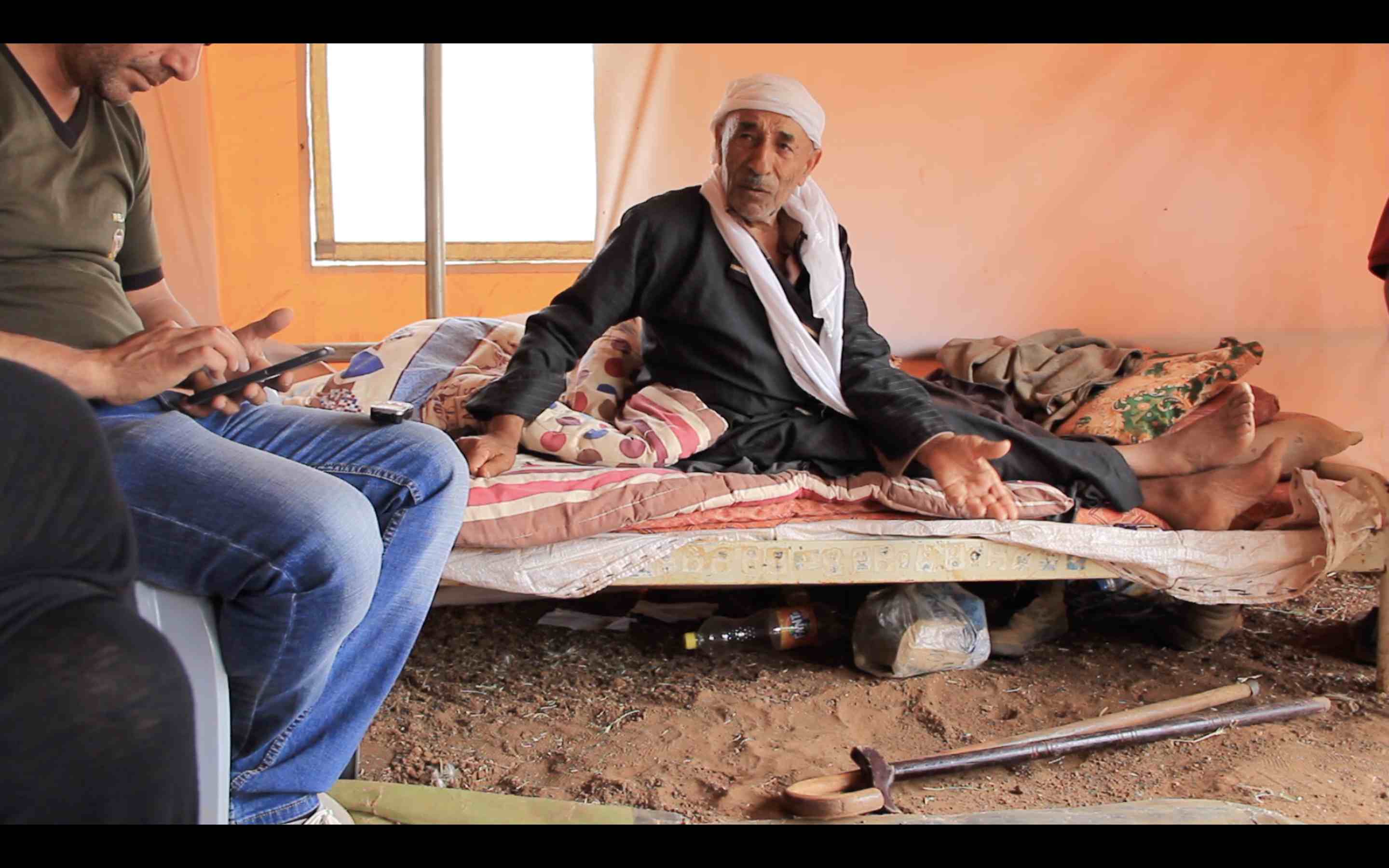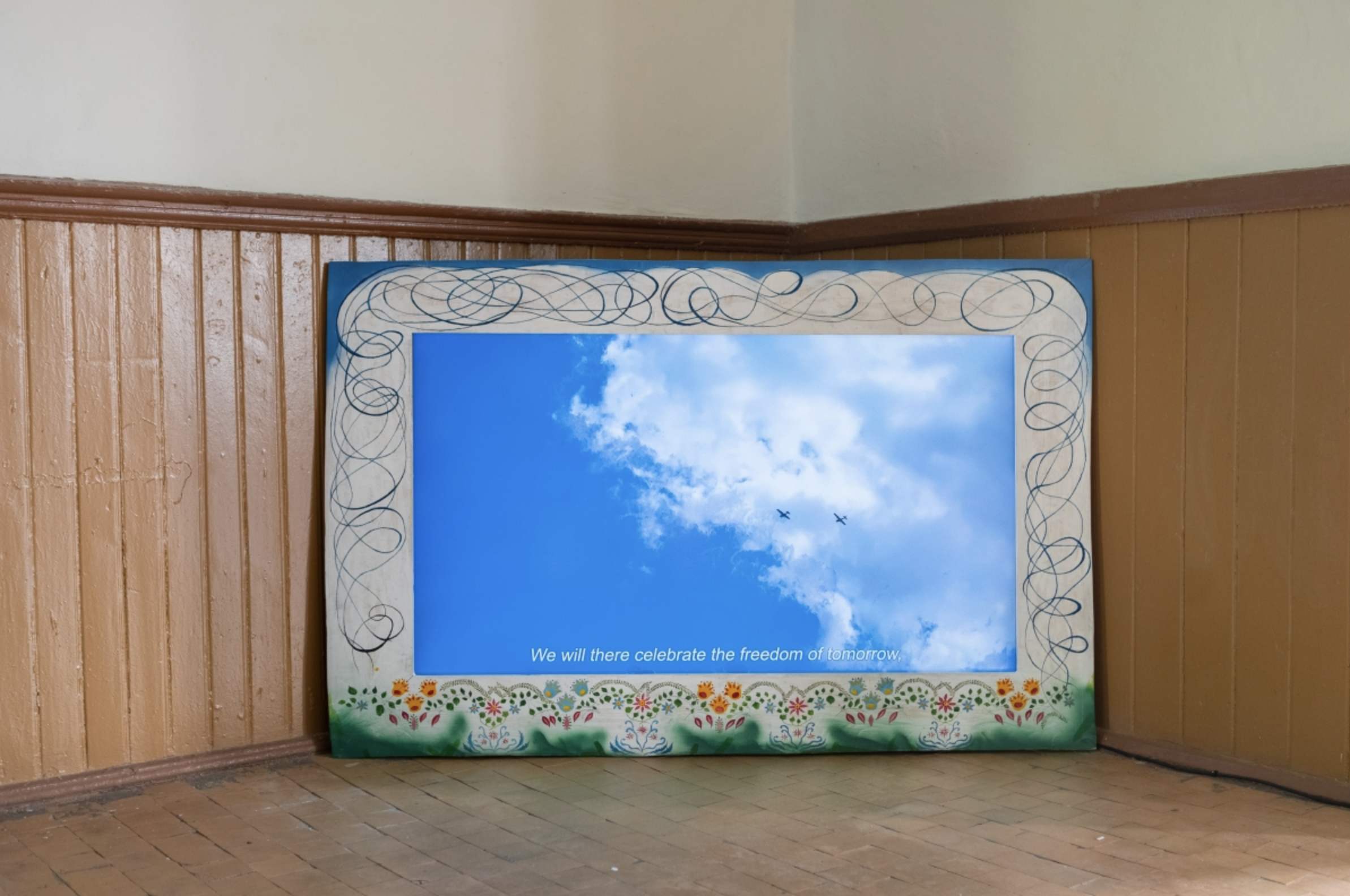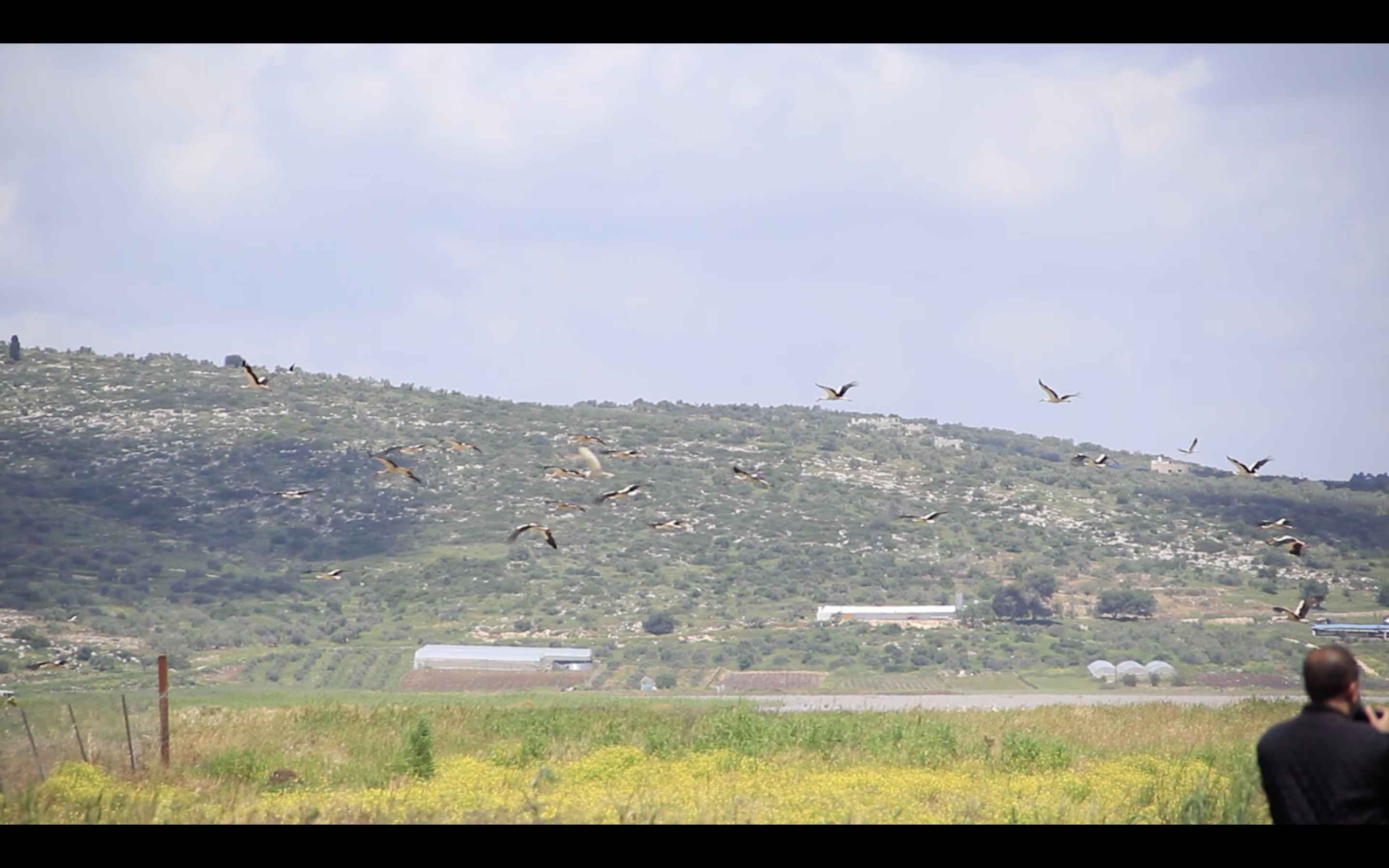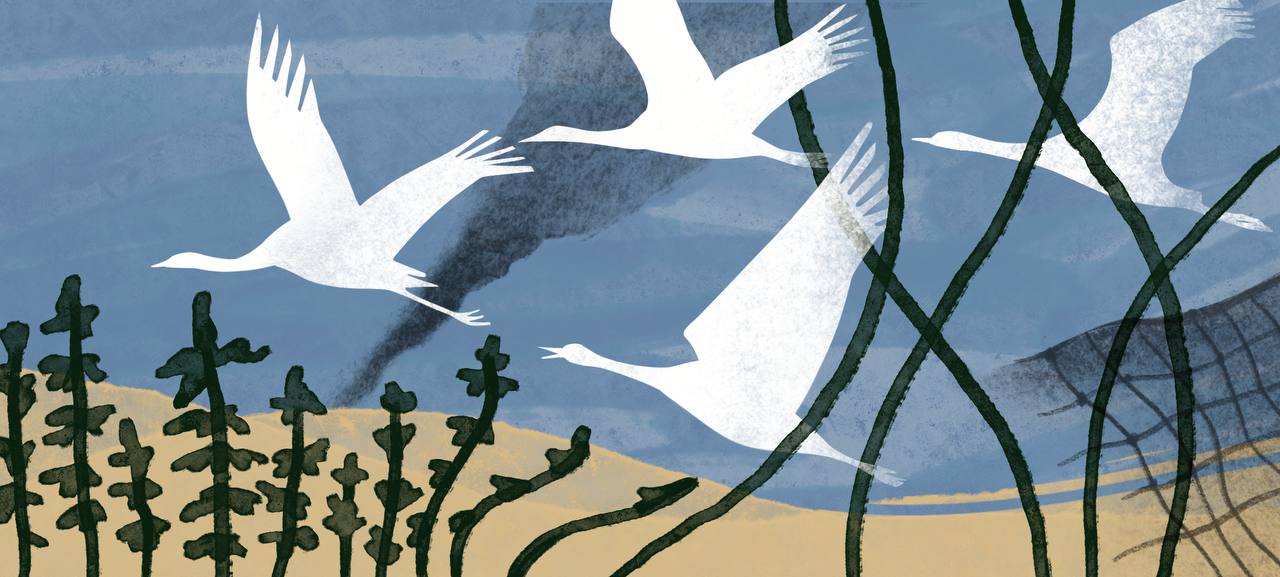I am welcomed to a modest temporary housing structure located near Tubas, a town in Area C of the West Bank, Palestine. The structure resembles a big tent made from an amalgam of fabrics: wooden, metal and other types of poles holding them in place – a reality made inevitable by the denial of permanent housing rights to Palestinians in the area. I set up my voice recorder and prepare to interview an elderly man resting on a tower of blankets arranged for the colder spring nights about his encounter with migratory storks in the area. Albeit migratory, traversing lands from Eastern Europe, via Middle East, towards South East Africa, these birds have acquired strong nationalistic characters across many Eastern European nations. I have set out to find out whether this folkloric significance resonates elsewhere along their route too – in Palestine to be more specific. I have been told that it is the elderly members of the community who hold the memories of these birds, as their presence rings no bells for the youngsters. And it is no surprise that these bells are not ringing, decreasing access to land and agriculture has diminished the stork population alongside their folkloric and ecological significance.

“????” says the man in Tubas, West Bank, Palestine. Image by Marija Nemcenko; 2019
The man is rather confused by my questions, to which he answers with a simple ???? (shu??), meaning what??, followed by a disapproving hand gesture. He states that they are weak birds, wondering why I came here all the way from Lithuania to enquire about them. I cannot help but wonder how a bird that flies over 8000 km is received as a weak bird. Well, simply because they come here and die, the man says. Amidst his remorse for the storks and their weakness, one thing becomes apparent: once there was water in the village and now there is none. Yet another phenomenon introduced by the occupation that Palestinians’ face. Indeed, the reason why the water sources for both local and migratory people, flora, and fauna disappear is the Israeli diversion of water flows, often to the nearby settlements to support their lavish lifestyle that “makes the desert bloom.” (Bazian, 2022) While water fountains signal the affluence of resources in the illegal settlements, the Palestinians outside of them face quite a different fate.
Water has long been a pressing issue for Palestinians. And in the light of the current Israeli war on Palestine it still is. Many are already aware of Israel’s cruel decision to turn off water for Gaza, following the Hamas attack on 7th October – an act that constitutes a war crime. This act stems from a long history of water crimes: from Israel controlling the majority of the water sources in the West Bank, which forces Palestinians to buy it from Israeli water companies at a different rate from what the Israelis pay; to the constant guerrilla style attacks by settlers on water wells in Palestinian villages. (Sánchez, 2022) In the case of the not-so-fond-of-the-storks man, the storks were “coming here and dying” simply because their inherited knowledge spoke of a place abundant with water – a perfect roosting ground. But to their surprise the water is gone, the land is dry, the ecosystem has changed, and there is no food and nothing to drink. What else is there to do?
Migrating birds and animals are not the only ones facing the direct consequences of the occupation. Indigenous species are severely affected by the separation wall too: animals’ hunting grounds were decreased and their movement was restricted, while plants were uprooted and ecosystems disturbed. (Husein & Qumsiyeh, 2022) The altered water flows affect the freshwater species, affecting in turn other species, affecting other species… affecting other species; a disastrous domino effect the world chooses to close its eyes to.


Photos from the exhibition 'Blessed are those that move' by Marija Nemcenko at Marcinkonys Station gallery. Photography: Laurynas Skeisgiela
The Israeli occupation poses multiple overlooked threats to the local ecosystem in the OPT (Occupied Palestinian Territories): water, walls, restriction of movement, urbanization, destruction of large swathes of wild or harvested plants, expropriation of natural resources, limitations imposed on Palestinian self-sufficiency and infrastructure management; the list could go on and on and on. And because Palestine is a key geographical zone for migrating species, this seemingly small area of land has reverberating consequences on worldwide ecosystems.
The magic of interdependence speaks to the intertwinement of species in one network of co-dependence, inseparable like twisted roots. If a component is disturbed, it will inevitably affect the others. The land of Palestine becomes one component in a bigger chain of interdependence. It should be obvious that when it hurts, so do we. To protect the environment, one cannot turn a blind eye to the occupation of Palestine, the separation wall there and to geopolitical borders overall.
So what exactly is there to do? Well, as is often the case with occupied lands it’s best to listen to the indigenous people. They are the gatekeepers to a deep well of local ecological wisdom. Palestinian identity is intimately tied to the land, offering both cultivated and uncultivated fruits. Their intangible heritage is rich with roots, and stems, and flowers, and leaves, and snake-like plants, or plant-like snakes. The gatekeepers of this ecological knowledge know how to use the roots, stems, flowers and leaves for food, for medicine and ritual. Traditionally, the Palestinian land and wild plants, growing in the valleys and on top of the hills, were a common-pool resource to which everyone had equal access. These resources constituted a premise for traditional Palestinian cultural identity. (Hanna, Friborg & Qumsiyeh, 2021) Not in the form of a lone health-food-crazy-adventure-seeker wandering into the wilderness to collect nutritional plants following a social media post, it was a social communal activity, around which even more traditions and rituals were built. Land to Palestine was like Palestine to land: intertwined entities supporting each other.
When the wilderness is not there anymore: shaved for the purpose of the apartheid wall and its safety buffer zones; dug out for the construction of illegal settlements under international law; or classified as an Israeli military zone made inaccessible to the Palestinians due to movement restriction; then the traditional ecological knowledge (TEK) constituting a large part of their intangible heritage is largely put at risk. (Husein & Qumsiyeh, 2022) The valleys and the mountain tops where Palestinian villagers used to forage are now conquered by the settlers, who in true colonial spirit perch on top of the hills and surveil. Since TEK is inevitably sensitive to the changing circumstances of the environment that living beings engage with, the knowledge about how human and more-than-human beings can cooperate and live together is shrinking in proportion with the shrinking lands that are constituted as Palestine.

Marija Nemcenko, exhibition view at Swallow gallery, 2022. Photo: Laurynas Skeisgiela
To save their traditional ecological knowledge some Palestinians replant the ecosystem on their private land – gardens, community spaces, and the like – while some, despite the restrictions, continue to forage. But those courageous ones that dare to forage, face another twisted obstacle: Israel’s conservation laws. The most infamous of them is banning the foraging of Akkoub (???? in Arabic) and Zaatar a wild Oregano (???? in Arabic), which are inextricably tied to Palestinian identity. In Palestine, Zaatar is not only the main herb in the national cuisine, but also among the miraculous plant categories that heal things from A to Z.
The Israeli government claims that Akkoub and Zaatar are on the brink of extinction and hence criminalize the foraging of these plants in the Occupied Palestinian Territories while establishing plantations for them in the illegally occupied West Bank. These plantations then sell to the Palestinians themselves as imported Israeli goods. As small as this gesture could be seen, it is tied to a larger labyrinth of head-scratching attempts to erase Palestinian identity and rights – if not their existence at large. For the generations of people whose livelihood and traditions were attached both to the plants and foraging, this policy is absolutely debilitating.
Artist Jumana Manna’s masterfully put-together film “Foragers” (2022) documents precisely this tension. Set as a chase movie, its narrative unfolds through an array of scenes united by acts of foraging. Whether it is Jumana Manna’s family bringing collected plants to the table, Israeli nature patrols chasing Palestinian foragers, or the courtroom investigations after their capture. Shifting from wide-angle to very intimate shots, the artist managed to accurately portray disparities in relationships to the land between the ones that presumably preserve the land, and the ones that actually know the land. With a pinch of humor, Manna portrays the absurdity of the situation where Palestinian grandma's and grandpas with baskets are being chased by Israeli nature patrols on Palestinian land. One captured elderly man states that no matter how big the fine will be, or how many times he will get caught, he will follow his dad’s, his grandad’s, and his grandad’s dad’s footsteps and continue foraging; defiantly keeping his Palestinian identity alive. It is perhaps because of such bravery that Palestinian culture exists no matter the barriers.
Responding to the facts of the decrease of native plants, the film powerfully asks us “what are the real causes driving these plants to extinction?” (Manna, 2022) Can it truly be the Palestinian elderly people with their handheld baskets? Or perhaps it is aforementioned reasons like increased urbanization, land clearance, expropriation, and microclimate destruction that are influencing the biodiversity of the West Bank and beyond? Reapproaching the whole matter from its true sources, we are prompted to ask “what then could be done to protect the native plants from extinction?” And well, here again, the local and indigenous people might hold the answers. And this question stands not only in relation to the land of Palestine, but as it was outlined before to the benefit of the intertwined world that we all inhabit.
Jumana Manna is amongst a lineage of Palestinian artists dealing with the concept of land, flora and fauna. Artists Basel Abbas and Ruanne Abou-Rahme's, Mirna Bamieh and Viviane Sansour are also amongst many others that are working with care to nurture seeds and local communities. Art institutions such as Dar Jacir or Sakiya in Bethlehem courageously take on the roles of fostering and displaying love for their lands alongside their communities, for whom an olive tree might as well sit around a table together with the family. Many of us who are artists, cultural workers, writers, critics, activists, etc., who increasingly care about our own lands, marshes and green spaces, have a responsibility to lend an eye, an ear and a hand to the artists and organizations in Palestine working to protect the land. We, in Eastern Europe, praise the plants, animals and birds that have become a part of our ecological and folkloric landscape. Let us take a moment to consider that these same plants, animals and birds that we revere might physically or at least metaphorically traverse Palestinian territories only to be faced with the harsh conditions of the occupation that will affect them too.

Migrating storks passing Merj Sanour, West Bank, Palestine. Image by Marija Nemcenko, 2019
As Israeli phosphorus bombs burn plants, animals and people in Gaza and Southern Lebanon, we yet again are asked to acknowledge that the occupational force is more concerned with expropriating the land than caring for it a.k.a. protecting it. There is a slogan that is widely used in pro-Palestine rallies today “no-one is free, until Palestine is free” and I would like to extend it to suggest that no land is protected, until Palestinian land is protected. Finally, I hang on the hope that when a land is taken by force a seed will always find a way. I leave it up to you to decipher this metaphor.
References:
Bazian, H. (2022) “Zionist Myth #2- “Made the Desert Bloom”, viewed 15th September 2023.
Fernanda Cáceres Sánchez, M. (2022) “The exploitation of natural resources in Area C of the West Bank as indicator of annexation“ in AFRICANA STUDIA, N.º 37, 2022, pp. 27 – 47
Hanna, M. E., Friborg, G. K., & Qumsiyeh, B. M. (2021): “Temporal change in traditional knowledge and use of wild plants in Artas, Palestine” in Palestine Exploration Quarterly, DOI: 10.1080/00310328.2021.1975069
Husein, D. & Qumsiyeh, B. M. “Impact of Israeli Segregation and Annexation Wall on Palestinian biodiversity“ in AFRICANA STUDIA, N.º 37, 2022, pp. 19 – 26)
Manna, J. (2022) Foragers with Jumana Manna, online interview, viewed 20th October 2023.



